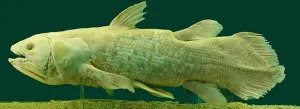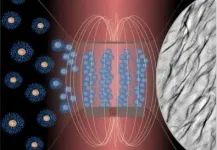(Press-News.org) The capture of the first living Coelacanth, a mighty ocean predator, off the coast of South Africa caused quite a stir in 1938, 65 million years after its supposed extinction. It became known as a "living fossil" owing to its anatomy looking almost identical to the fossil record. But while the Coelacanth's body may have changed little, its genome tells another story.
Toronto scientists have now revealed that the African Coelacanth, Latimeria chalumnae, gained 62 new genes through encounters with other species 10 million years ago. Their findings are reported in the journal Molecular Biology and Evolution.
What's even more fascinating is how these genes came about. Their sequences suggest they arose from transposons, also known as "selfish genes". These are parasitic DNA elements whose sole purpose is to make more copies of themselves, which they sometimes achieve by moving between species.
The findings show the dramatic effect traveling transposon DNA can have on the creation of genes and provide a glimpse into some of the forces that shaped the genome of one of the most ancient and mysterious organisms.
"Our findings provide a rather striking example of this phenomenon of transposons contributing to the host genome," says Tim Hughes, senior study author and a professor of molecular genetics in the END
Not a living fossil: How the Coelacanth recently evolved dozens of new genes
Coelacanths gained 62 new genes from traveling DNA that was passed on from other species, new research reveals in a remarkable glimpse into how the genome of one of the most ancient and mysterious organisms evolved
2021-02-09
ELSE PRESS RELEASES FROM THIS DATE:
Why does love of bargain hunting run in families?
2021-02-09
Headlines like "Black Friday Shoppers Trampled in New York" and popular television shows such as "Extreme Couponing" remind us how crazy consumers can get about retail sales promotions. This enthusiasm for getting bargains has been termed "deal proneness."
Past research has indicated that, to some degree, people become deal prone through being taught by their parents. But a new paper, "Born to Shop? A Genetic Component of Deal Proneness," published in the Journal of the Association for Consumer Research, provides evidence that our genes also play a role in causing bargain-hunting enthusiasm.
To demonstrate this genetic factor, authors Robert Schindler, Vishal Lala, and Jeanette Taylor ...
Can super-Earth interior dynamics set the table for habitability?
2021-02-09
Washington, DC-- New research led by Carnegie's Yingwei Fei provides a framework for understanding the interiors of super-Earths--rocky exoplanets between 1.5 and 2 times the size of our home planet--which is a prerequisite to assess their potential for habitability. Planets of this size are among the most abundant in exoplanetary systems. The paper is published in Nature Communications.
"Although observations of an exoplanet's atmospheric composition will be the first way to search for signatures of life beyond Earth, many aspects of a planet's surface habitability are influenced by what's happening beneath the planet's surface, and that's where ...
Researching ways to improve sustainability and reduce waste in the seafood industry
2021-02-09
Nutritionists have been touting the health benefits of seafood for years. Dietary guidelines recommend that the average adult get at least two servings of seafood per week. But the push to increase our consumption of seafood can put a strain on the seafood industry and create more waste.
"Many fisheries are fully or overexploited," said Lekelia "Kiki" Jenkins, an associate professor at Arizona State University's School for the Future of Innovation in Society in the College of Global Futures. "We are pushing our fisheries to the brink that they can sustain. Meanwhile, consumers are wasting nearly half of the fish they buy. We need to understand our waste behaviors and put a mechanism into place so that we use what we catch."
Jenkins is researching ways to improve sustainability in ...
Sonoporation: Underlying mechanisms and applications in cellular regulation
2021-02-09
Announcing a new article publication for BIO Integration journal. In this review article the authors Yue Li, Zhiyi Chen and Shuping Ge from First Affiliated Hospital of University of South China, Hengyang, China and Tower Health and Drexel University, Philadelphia, PA, USA summarize current state of the art applications of microbubble-cell interactions and sonoporation effects to cellular functions.
Ultrasound combined with microbubble-mediated sonoporation has been applied to enhance drug or gene intracellular delivery. Sonoporation leads to the formation of openings in the cell membrane, triggered by ultrasound-mediated oscillations and destruction of microbubbles. Multiple mechanisms are involved in the occurrence ...
Nanocarriers in the enhancement of therapeutic efficacy of natural drugs
2021-02-09
Announcing a new article publication for BIO Integration journal. In this review article the authors Xiuling Li, Shunung Liang, Chee Hwee Tan, Shuwen Cao, Xiaoding Xu, Phei Er Saw and Wei Tao from Sun Yat-sen University, Guangzhou, China, Guangzhou University of Chinese Medicine, Guangzhou, China and Center for Harvard Medical School, Boston, MA, USA discuss the potential benefits of four plants endogenous to China and the enhancement of their therapeutic efficacy by nanotechnology intervention.
Plant derived natural products have been used for the treatment of various human diseases long before the intervention of modern medicine. The basis of modern medicine is still inspired by traditional medicine and therapies. However, ...
Scientists urge for investment now in highly potent vaccines to prevent the next pandemic
2021-02-09
LA JOLLA, CA--As new COVID-19 variants begin to throw vaccine efficacy in question, two leading scientists are calling for health agencies to invest in the development of vaccines that would be broadly effective against many different variants and strains of potential pandemic viruses.
In a END ...
Scientists create flexible biocompatible cilia that can be controlled by a magnet
2021-02-09
Researchers at the University of Campinas's Chemistry Institute (IQ-UNICAMP) in the state of São Paulo, Brazil, have developed a template-free technique to fabricate cilia of different sizes that mimic biological functions and have multiple applications, from directing fluids in microchannels to loading material into a cell, for example. The highly flexible cilia are based on polymer-coated iron oxide nanoparticles, and their motion can be controlled by a magnet.
In nature, cilia are microscopic hairlike structures found in large numbers on the surface of certain cells, causing currents ...
Can current smartphone technology tell you when a pandemic might come calling?
2021-02-09
Photoplethysmography (PPG) is a simple optical technique used to detect volumetric changes in peripheral blood circulation. It's used in smart watches, for example, to monitor pulse and heart rate, but PPG biosensors are also found in millions of smartphones, but without any current clinical applications.
In a study published online in the February 2021 issue of Chest, researchers at University of California San Diego School of Medicine, with industry collaborators, found that already embedded PPG in smartphones, in tandem with application software, could be used for remote clinical pulse oximetry to manage chronic cardiopulmonary disease and perhaps initial treatment and monitoring of persons affected in respiratory viral pandemics, such as COVID-19.
"Pulse oximetry monitoring ...
Design and deployment of COVID-19 technology responses and finding ways to make things
2021-02-09
As governments try to mitigate the spread of COVID-19, many are turning to contact tracing, including apps that track your location and electronic check-in QR codes. But with that technology come questions of personal safety, privacy, trust, control and collective action. So what can be done to improve these large-scale technological system roll-outs without infringing on a citizen's right to privacy?
"These systems are logging your physical social network," said Katina Michael, an Arizona State University professor at the School for the Future of Innovation in Society in the College of Global Futures and the School of Computing, Informatics and Decision Systems Engineering in the Ira A. Fulton Schools of Engineering. "The physical has become more ...
Shining a light on the true value of solar power
2021-02-09
Beyond the environmental benefits and lower electric bills, it turns out installing solar panels on your house actually benefits your whole community. Value estimations for grid-tied photovoltaic systems prove solar panels are beneficial for utility companies and consumers alike.
For years some utility companies have worried that solar panels drive up electric costs for people without panels. Joshua Pearce, Richard Witte Endowed Professor of Materials Science and Engineering and professor of electrical and computer engineering at Michigan Technological University, has shown the opposite is true -- grid-tied solar photovoltaic (PV) owners are actually subsidizing their non-PV ...
LAST 30 PRESS RELEASES:
UF dives deep into predicting storm damage with computer models
A stormy ocean voyage yields insights on the global carbon cycle
Scientists identify first non-coding gene that controls cell size
Demonstration of altermagnetism in RuO₂ thin films -- A new magnetic material for the AI era
Penn researchers awarded $25M to conduct trial using smartphones to fight heart disease
PCORI awards funding for new patient-centered healthcare research
Exploring the origins of the universe: 145 low-noise amplifiers complete ALMA telescopes
Empress cicada wings help illuminate molecular structure
Using sound waves to detect helium
Time burden in patients with metastatic breast and ovarian cancer from clinic and home demands
Researchers discover bias in AI models that analyze pathology samples
Scientists ID potential way to prevent brain injuries from triggering Alzheimer's
MASTER 2nd Open Call: Execution period kick-off
Algae for health in food and pharma
Advanced microrobots driven by acoustic and magnetic fields for biomedical applications
Chicago health information leader recognized for raising CPR readiness and blood pressure awareness
The Intimate Animal, a new book from Kinsey Institute Executive Director Dr. Justin Garcia
When blue-collar workers lose union protection, they try self-employment
New video dataset to advance AI for health care
MEA-based graph deviation network for early autism syndrome signatures in human forebrain organoids
New modeling approach sheds light on rare gut disease
Study documents potentially hazardous flame retardants in firefighter gear
Can certain bacteria regulate aging of the immune system and its related alterations?
AI model helps diagnose often undetected heart disease from simple EKG
There are fewer online trolls than people think
Cell membrane fluctuations produce electricity
Jeonbuk National University study shows positive parenting can protect adolescents against self-harm
Surface-engineered ZnO nanocrystals to tackle perfluoroalkyl substance contamination
This new understanding of T cell receptors may improve cancer immunotherapies
A new fossil face sheds light on early migrations of ancient human ancestor
[Press-News.org] Not a living fossil: How the Coelacanth recently evolved dozens of new genesCoelacanths gained 62 new genes from traveling DNA that was passed on from other species, new research reveals in a remarkable glimpse into how the genome of one of the most ancient and mysterious organisms evolved



